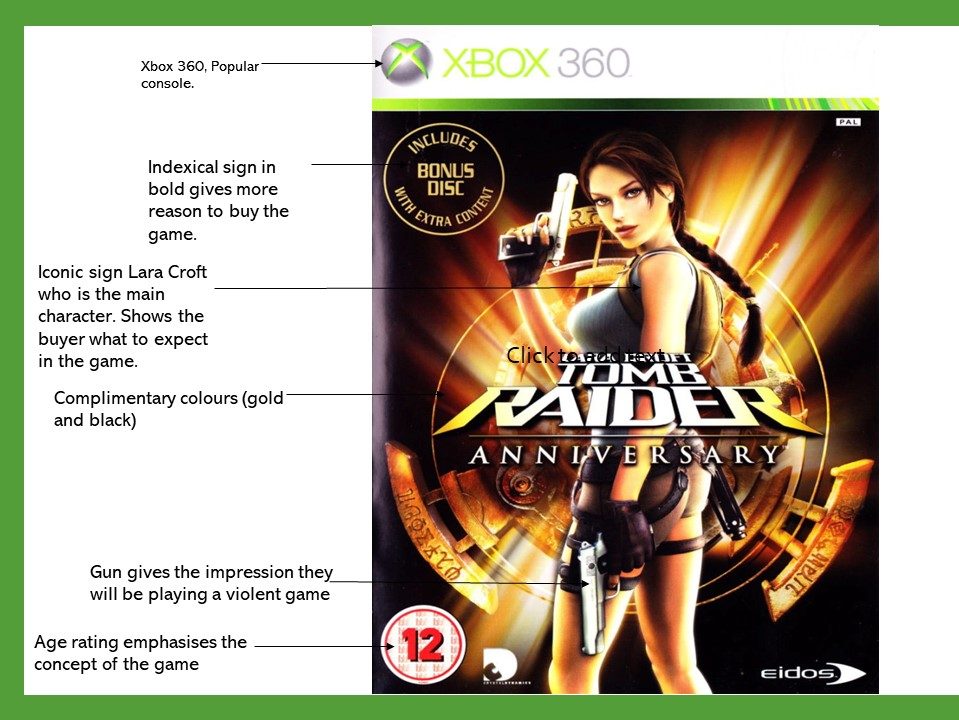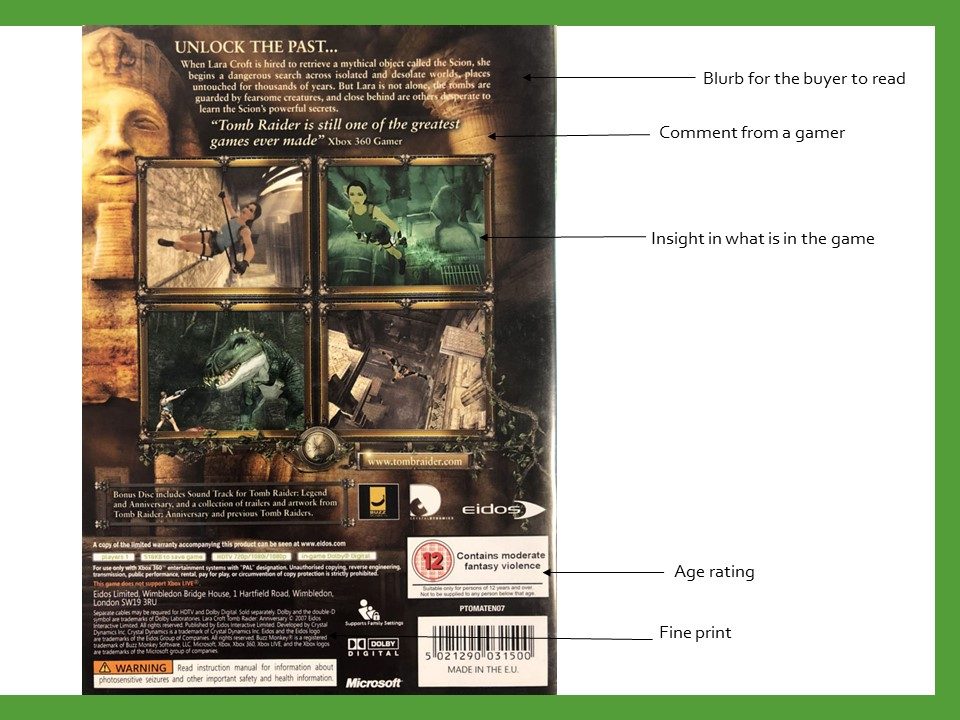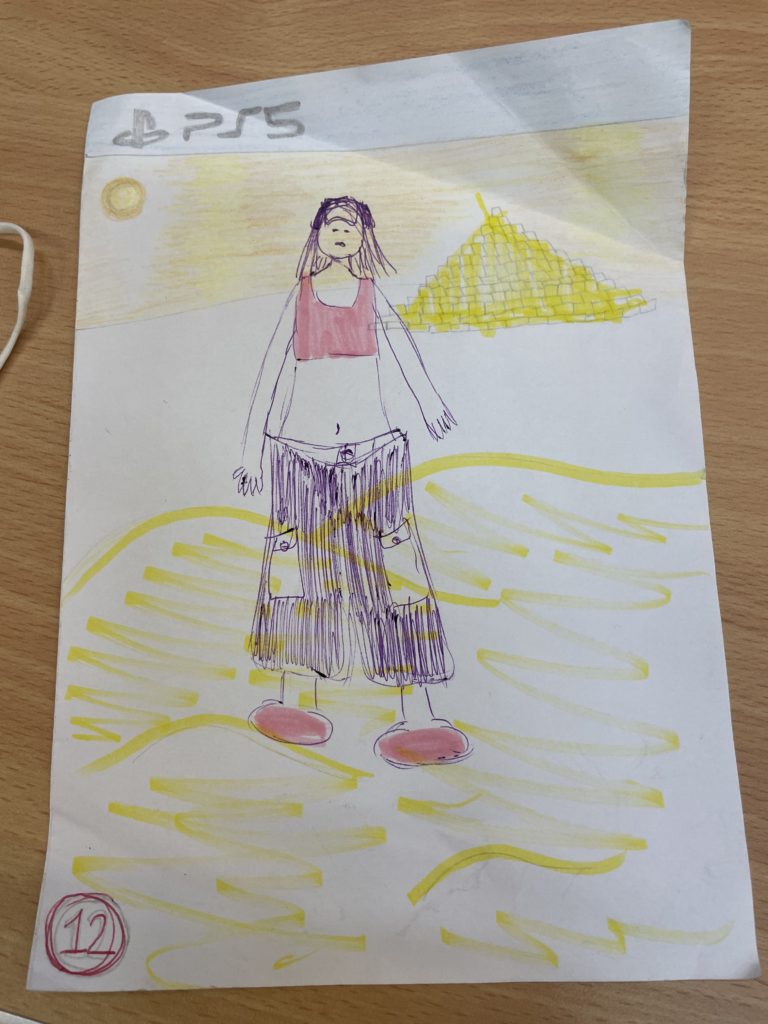In this essay I am going to apply semiotic analysis to both the game covers Tomb Raider and Metroid, the front cover for the video game Tomb Raider is misrepresenting reality, this is through how the dominant signifier is represented (Lara Croft), she is seen to be wearing clothes that will cause the male gaze and voyeurism. Another way the games producers have further tried to emphasise this is by placing the anchorage of the image on her waist, making the upper and lower part of the body clearer to the eye at first glance. As Laura Mulvey said “The ‘male gaze’ is something that sexualizes women by empowering men and objectifying women. In the ‘male gaze’ the women are objectified to fit the wants of the heterosexual male.” Ferdinand De Saussure’s ideology is still holding up in today’s world with the idea of the signifier (being the object itself) and signified (being the meaning of the object) this is clear as the way the signifier (the guns) is being signified with the dominant signifier holding them in both hands to suggest that there is and should be violence, which is not the case in today’s society and this makes a myth. On the other hand, Tomb Raiders front cover for the video game can radical as it goes against the patriarchal society. This game also goes against collective identity and suggests to women that you don’t have to a “damsel in distress” as the feminist frequency group put forward. Lara Croft is also a countertype as she goes against the traditional stereotypes set up with women. Girls as young as 12 or even younger if they are not listening to the age restriction will be playing this game and taking in everything about it without even know that they are doing that. As John Berger said “The book “ways of seeing” says in it that women from their earliest childhood have always had to survey themselves constantly. She is told that is it crucial on how she appears to men as it determines how successful she is in life.” This is true in the sense that the way Lara croft is dressed, suggesting that girls should dress like that. However she is also empowering girls as she is seen as strong and adventurous with the video game itself. Modern media is saying that (Leveling up) “Despite many video game companies being based in East Asia, most games feature white protagonists.” However, this is and isn’t the case for Tomb raider, on the first part their game was produced by the games company eidos which is based in Montreal Canada however on the other hand the game does feature a white caucasian being Lara Croft.
The front cover of the video game Metroid is a myth, its trying to represent a sci-fi like video game through the use of unrealistic guns and armour. The game is promoting violence with the signifier (the gun). He creates a constructed reality for people who want a breakthrough with reality this could be negative as it disconnects people from reality and facing their fears. It also creates a constructed identity for the one who is playing the game as the person is controlling everything that character does using the controller. Samus being the dominant signifier is a icon to many with his gun being an index to samus and the title would be a symbol. There is no negotiated identity with samus, as the game creators get to decide this, you could see the creators being the hegemony of the video game which could be seen as a negative thing. However not everything about this game is negative, in fact there are many positives. You may get a patriarchal view at first with the dominant signifier (samus) with the suit, gun and male stance, but in fact the person inside the suit is female, this stops voyeurism for the heterosexual male as the character can be seen as female and male. When you realise that samus is actually a female you would think of samus as a counter-type. The game cover has also tried to show that this is a video game through using a syntagm in the front cover with the logo of the Nintendo game cube, the age rating and the games company it was created by. The front cover always warns it uses of how they should play the game by adding an age rating to it in the bottom left hand corner however if someone were to be less than that age they might not notice it as there is no colours such as red, being a dangerous colour, to warn them. It indicates that you should be at least twelve or more to play the game however there is nothing restricting someone who less than that age playing the game. This can cause big issues to audience playing the game as people who are less than the age are susceptible to inheriting these ideals and putting them into practice where they were to use a gun in real life and think its just part of the game. But as the fluidity identity of the audience changes as time passes they might take these ideals with them or push them aside and forget about them.
In this essay I have argued that Tomb raider is a game is created to please the sexual desire of the heterosexual man whilst also having a fun and creative side to the game as well and I have argued that Metroid promotes violence and how man should be in society whilst being able to creating a escape from reality.




